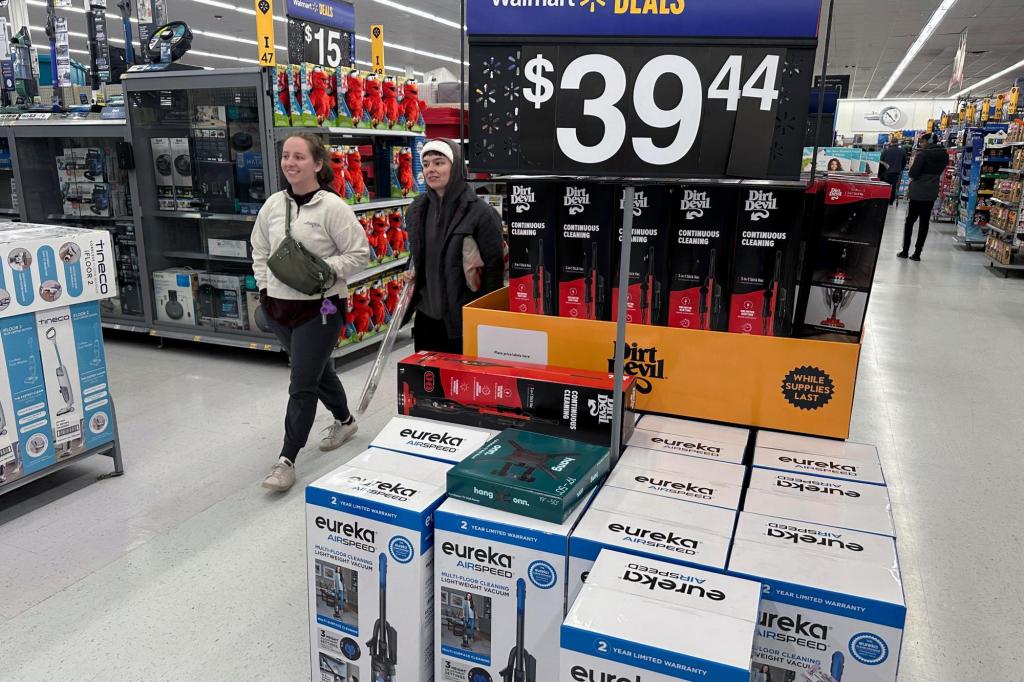
By ANNE D’INNOCENZIO, Associated Press Retail Writer
NEW YORK (AP) — Walmart delivered another year of strong sales and profits with its competitive prices an increasingly strong magnet for inflation-weary shoppers, but 2025 appears to come with new challenges in an uncertain economic landscape.
The outlook from the nation’s largest retailer for 2025 is as much as 27 cents below analyst projections for per-share earnings and for the quarter, Walmart’s expectations are as much as 7 cents below Wall Street projections.
Its sales outlook is also disappointing, potentially a reflection of rising challenges ahead as consumers pull back on spending and President Donald Trump’s tariffs on China and other countries threaten the low-price model that is the core of Walmart’s success.

Walmart has built in hedges against some tariff threats. Groceries account for roughly 60%, of its U.S. business, according to the company’s most recent annual report, meaning a huge chunk of sales are not reliant on goods made in China or elsewhere.
Still, shares tumbled nearly 9% before the opening bell Thursday and it pulled other big retailers down with it. The retail sector is the biggest decliner in premarket trading and Target slid 2%.
Walmart is among the first major U.S. retailers to report quarterly financial results and numbers could provide a hint as to the mood of the American shopper, particularly amid new trade barriers that according to most economists threaten to reignite inflation. Consumers over the past year have increasingly focused more on necessities rather than TVs, furniture or appliances. They’ve become much more discerning about big-ticket purchases because of higher costs for credit as well as for groceries.
Walmart has flourished in that environment, using its clout to keep prices down. It’s gained market share, notably among households with incomes over $100,000. Walmart’s online offerings and paid membership, Walmart +, have also drawn wealthier customers
“We have momentum driven by our low prices, a growing assortment, and an eCommerce business driven by faster delivery times,” said CEO Doug McMillon. “We’re gaining market share, our top line is healthy, and we’re in great shape with inventory.”
Still, Walmart could be faced with challenges with the new tariffs carrying more economic risks than during Trump’s first term. If Americans are hit by a new wave of price increases, economists say, and with 70% of the U.S. economy driven by consumers a broad pullback in spending would have ramifications beyond Walmart’s sales.
Government data last week revealed a sharp drop in January retail sales as cold weather kept more Americans indoors. But it was a much bigger drop than economists expected and the biggest in a year. Sales were revised higher for December, possibly indicating a pullback by consumers after a holiday season splurge.
Yet grocery prices, a sore point for American households, continued to rise.
Walmart, based in Bentonville, Arkansas, reported earnings of $5.25 billion, or 65 cents per share, in the quarter ended Jan. 31. That compares with $5.49 billion, or 68 cents per share, in the year-ago period. Adjusted earnings per share for the most recent quarter was 66 cents.
Sales rose 4.1% to $180.55 billion in the quarter.
Analysts expected 65 cents per share on sales of $180.07 billion in the fourth quarter, according to FactSet.
For Walmart’s U.S. division, comparable store sales — which include online and stores open for the past 12 months — rose 4.6% in the U.S., a bit lower than the 5.3% in the previous quarter. The retailer had a 4.2% jump in the U.S. in the second quarter and 3.8% in the first quarter.
Global e-commerce sales rose 16% in the latest quarter, notably slower than the 27% increase in the third quarter.
Walmart expects first quarter earnings per share of between 57 cents and 58 cents, well below the 64 cents Wall Street was expecting, and for the year. Walmart expects earnings per share in the range of $2.50 to $2.60. That’s also off the $2.77 that analysts are predicting, according to FactSet.
It forecast a 3% to 4% increase in quarterly sales or between $166.35 billion and $167.97 billion. That could be a letdown for industry analysts, who had expected sales of $167.05 billion, according to FactSet.
Walmart expects sales to be up anywhere between 3% to 4% for the current year, or between $667.57 billion and $674.05 billion. That too falls short of the $708.72 billion that analysts predicted, according to FactSet.
Originally Published:





